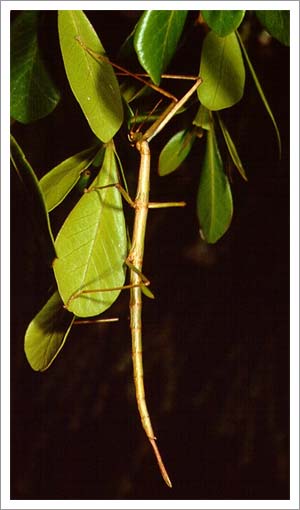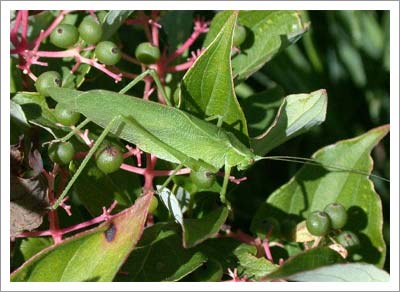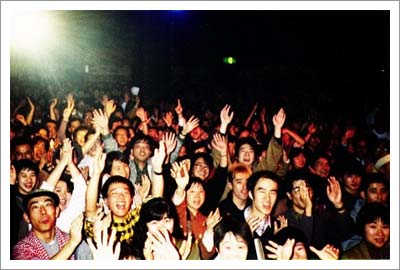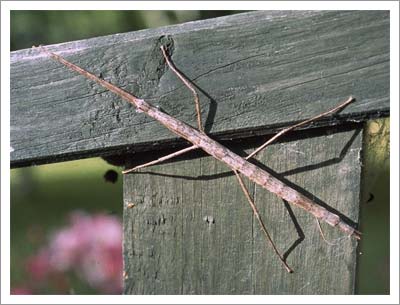My favorite animal behavior documentaries (other than porn) are on the subject of camouflage. I was watching one about insects the other day and was amazed by the astounding cleverness certain species demonstrate through their survival strategies.
One that captured my fancy was the walking stick. It looks exactly like a stick, except it walks, eats and reproduces. It even has patches resembling moss and bark on its exoskeleton. Walking sticks are not very ambitious, content to live their lives just pretending to be sticks. Another fascinating adaptation is found in the various species of bugs that resemble leaves. Known as, well, leaf bugs, they reside, not surprisingly, around leaves. Some are green and some are a mottled brown. A few gyrate their bodies in response to the wind, mimicking the way real leaves behave on a breezy day. Leaf bugs spend their days eating, dancing and trying to have sex with other leaf bugs, which isn't as exciting as it sounds. Imagine, if the leaf bugs and the walking sticks ever teamed up, they could get together to form an incredible super-organism: the bush.
A certain butterfly caterpillar is also particularly clever. The coloration of its body has evolved to look like bird droppings. Since caterpillars are roughly the same size and shape as bird poop, a blotchy, off-white color scheme is all it takes to deftly complete the illusion. With so many culinary options out there, fecal matter is usually the last entree on the list for any animal, aside from the occasional curious dog, so a convincing poop impersonation is downright brilliant from a survival perspective.

Fig1. A walking stick tries to act casual.
So I got to thinking. What kinds of camouflage exist in urban environments? What survival strategies do we humans employ? How do we make ourselves less conspicuous?
Though we long ago left the open savannah, we still exist in world of predators and blending in is just as important today as it was back then. A city offers much to mimic.
It's all about being noticed -- or rather, not being noticed. If we truly wanted to disappear, we would wear brick, concrete or marble-patterned clothing in order to match the buildings and sidewalks. Light poles, newspaper boxes, fire hydrants can be found on every street and our clothing should be modeled after them. Bad advertising would further ensure survival. A coat could offer laser hair removal services. A sweater could display registration deadlines for a nearby technical college. A pant leg may resemble a wallpapered telephone pole announcing parties, dog walking services, guitar lessons and free kittens. To achieve maximum invisibility, of course, the wearer would have to stand still, as telephone poles and newspaper boxes tend not to move much.
Of course, these enhancements, despite their brilliance, are not practical. If only it were as simple as mimicking the background we could enjoy the luxuries of the leaf bug. But life in the urban jungle is intricate and complicated. There exist certain standards of behavior and dress that only the foolish ignore. To survive in the modern world, we must operate according to a wide-ranging set of unspoken rules. Do otherwise and there are consequences, and nobody likes consequences. We simply want to go about our lives eating, dancing and trying to have sex with other humans.

Fig2. Leaf bugs have a tough life: eat, dance, sex.
Clothing is about communication. What we wear broadcasts information about ourselves to others and it usually boils down to one of two basic messages: "I am one of you" or "I am not one of you." By simply wearing certain things you advertise your allegiance to a particular lifestyle or belief structure. Every class, creed or clique has its own sense of dress that makes membership clear. We wear ourselves on our sleeves, quite literally.
Self-expression is allowed, of course, but it must fall within a range of acceptable practices. Ours is, after all, a semi-uniformed society. Everybody fits under a label or two, involving varying levels of bagginess, material and color coordination. Within these peer groups, motivations become conflicting. We want to fit in while simultaneously standing out. We want to be invisible to some, but we desperately want others to notice us, and by "others" I mean potential employers and/or possible sexual partners. Everyone else can remain in the din.
At the same time, though, outward appearance and inward reality don't always match -- often on purpose. Who we are and who we want people to think we are are not always the same. Clothing is a way of controlling that, of deceiving the world at large, of deceiving ourselves. In many ways, clothing gives us the gift of the chameleon. We become shape-shifters. Our clothes allow us to alter our identities at will; we can take on different personas or satisfy the requirements of any number of events. There is a shoe for every occasion, and they all fit. This is why nakedness is often uncomfortable: it forces us to face reality. No one can look at him- or herself in the nude and be anything but honest. The truth is not always pretty, so we hide from ourselves as much as from the predators out there.
The one constant, though, is blending in. Being a part of the crowd is the whole point. There is safety in numbers, in being a sheep indistinguishable from the next. Anonymity is comforting. It's true.
American urban-dwellers accomplish this by wearing dark clothes -- browns, blues and blacks, with the occasional gray or green slipping in to spice things up. Bright colors are reserved for things like scarves and panties and the occasional sporting event. Rarely do you see an urbanite in something flashy or attention grabbing -- those who wear bright clothes are either from the suburbs or Europe. We dress this way precisely to distinguish ourselves from the visiting hordes of tourists. Scammers, criminals and beggars are not stupid. They are actually skilled profilers. They can spot a suburban kid a mile away and not a single one doesn't have a highly refined European-dar he uses at least once a week. It isn't so much that they don't bother people living in the city, it's just that they have a higher success rate with people unaccustomed to ignoring them. And those people just happen to be easy to spot.

Fig3. Concert-goers demonstrate how not to blend in.
As demonstrated so ably by the leaf bug, camouflage is not purely about appearance. It's also about behavior. In an urban setting, one's behavior can determine whether or not someone files a police report and calls his insurance company or just waves the other driver on after a small fender-bender. Again, it comes down to not standing out. There is a certain range of acceptable behavior that is considered normal. This range isn't easily defined and its borders are constantly changing, but it's there. It is most easily recognized not by what falls within it but by what doesn't. You know it when you see it. There is simply no survival advantage to exceeding what's acceptable. Attention is only desirable if the person giving it has a job that needs filling or genitals you want to play with.
Urban jungles are relatively new environments on the evolutionary timeline. As far as we know, we're the first species to build them, but we're not the only species to live in them. While our rise to the top of the food chain has proven detrimental for most animals, for some it is a windfall. Our environs are inhabited by all sorts of creatures. Some are brought here on purpose, such as dogs, cats, fish and English-speaking birds. Even the squirrel is tolerated, given its above-average ability to entertain on really boring days. Others came on their own, and are considered nothing but nuisances -- non-English-speaking birds, rats, mice and a whole slew of hungry, determined insects. Those that thrive on garbage are in hog heaven because if there's one thing humans do best, it's create waste and there is no shortage of it.
Still, there are relatively few animals and insects amongst us when you consider how many inhabit the jungles and forests, which have had a lot more time to recruit a population. It won't be long before our favorite insects make the big move to the big city. They simply need time to evolve the proper adaptations. A city offers much to mimic.
There will be a day when the sight of a yellowish, stick-like bug ceases to surprise. It will have distinct edges, smooth sides, a muted oily texture, be anywhere from one to four inches long and have a bit of red on one end. Of course, on account of its camouflage, spotting one will be difficult and rare, and walking fries will soon infest many of our eating establishments.

Fig4. A walking stick demonstrates its poor urban camouflage.
If the leaf bugs ever want to successfully relocate to a city, they'll need to become cigarette bugs. Light brown on one end and white on the other, they'll lay flat to the ground like smashed Marlboros, skittering in the wind on sidewalks and in gutters.
And the bird poop caterpillar would fare quite well in a city. The only minor adaptation I would suggest is an aversion to sidewalks, roads, park benches and any other area a dog or shoe could conceivably reach. Otherwise, it would be free to procreate with abandon secure in its unappetizing fa�ade.
Then again, maybe they don't need to change at all. Maybe they're fine just the way they are. Maybe they're already here. Look closely at the next bush you pass -- it might not be there when you get back.





